FY028-21S2RE: Inquiry Based Learning - GAP's Response to Retail Trends
VerifiedAdded on 2023/06/12
|15
|3046
|128
Report
AI Summary
This report investigates the impact of retail trends on fast fashion chains, focusing on GAP as a case study. It identifies key trends such as digital technology adoption, mobile payments, Omni-channel retailing, and the demand for sustainability. The analysis includes a PESTLE analysis, highlighting the effects of political factors like the US-China trade war, economic factors such as the US economic situation, social media influence, technological advancements, legal issues like counterfeiting, and environmental concerns related to sustainable fashion. A SWOT analysis assesses GAP's strengths, weaknesses, opportunities, and threats. The report concludes with recommendations for GAP, emphasizing the importance of investing in digitization, personalization, and sustainability to maintain competitiveness and achieve continuous growth in the evolving fast fashion retail landscape.

FY028-21S2RE:
Inquiry Based
Learning-21S2RE
Inquiry Based
Learning-21S2RE
Paraphrase This Document
Need a fresh take? Get an instant paraphrase of this document with our AI Paraphraser
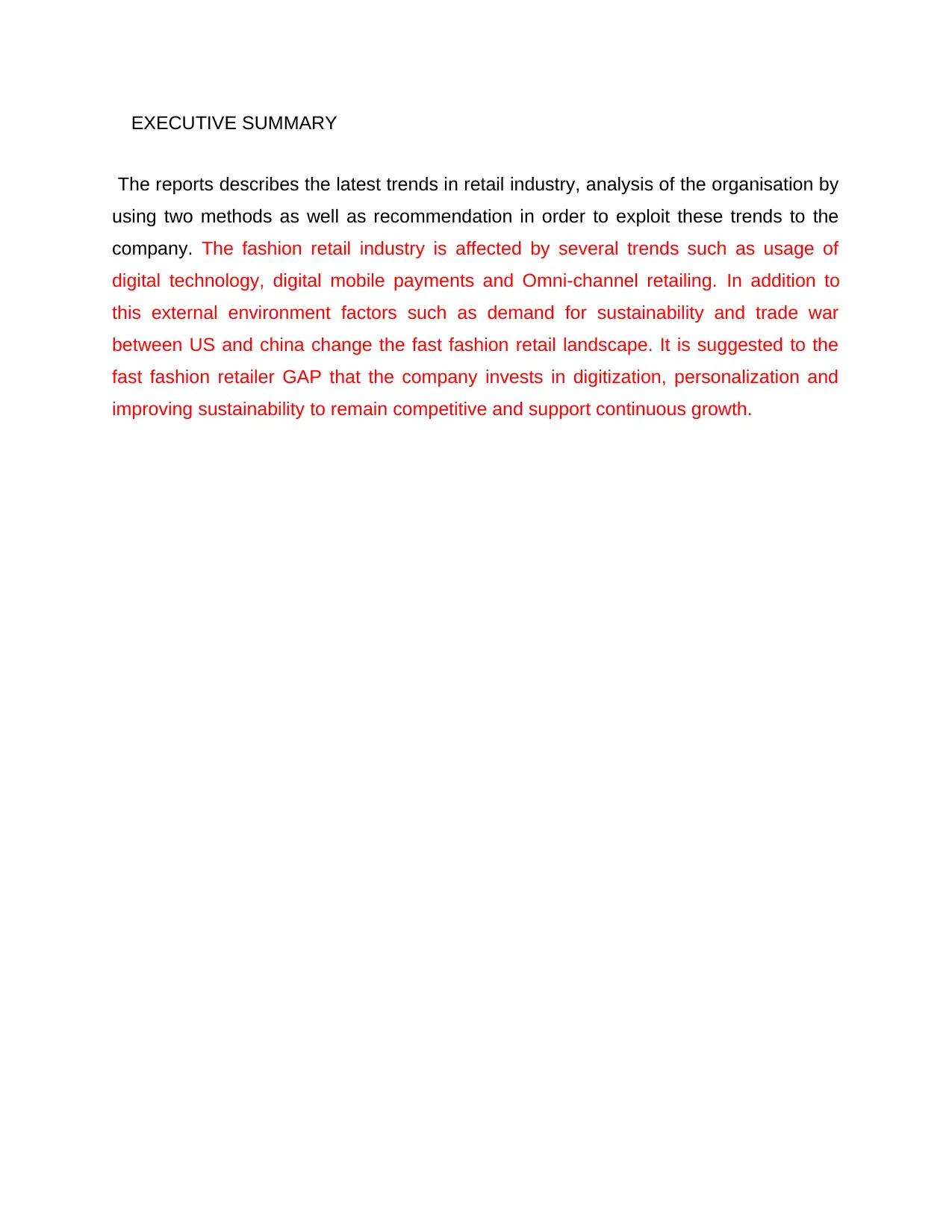
EXECUTIVE SUMMARY
The reports describes the latest trends in retail industry, analysis of the organisation by
using two methods as well as recommendation in order to exploit these trends to the
company. The fashion retail industry is affected by several trends such as usage of
digital technology, digital mobile payments and Omni-channel retailing. In addition to
this external environment factors such as demand for sustainability and trade war
between US and china change the fast fashion retail landscape. It is suggested to the
fast fashion retailer GAP that the company invests in digitization, personalization and
improving sustainability to remain competitive and support continuous growth.
The reports describes the latest trends in retail industry, analysis of the organisation by
using two methods as well as recommendation in order to exploit these trends to the
company. The fashion retail industry is affected by several trends such as usage of
digital technology, digital mobile payments and Omni-channel retailing. In addition to
this external environment factors such as demand for sustainability and trade war
between US and china change the fast fashion retail landscape. It is suggested to the
fast fashion retailer GAP that the company invests in digitization, personalization and
improving sustainability to remain competitive and support continuous growth.
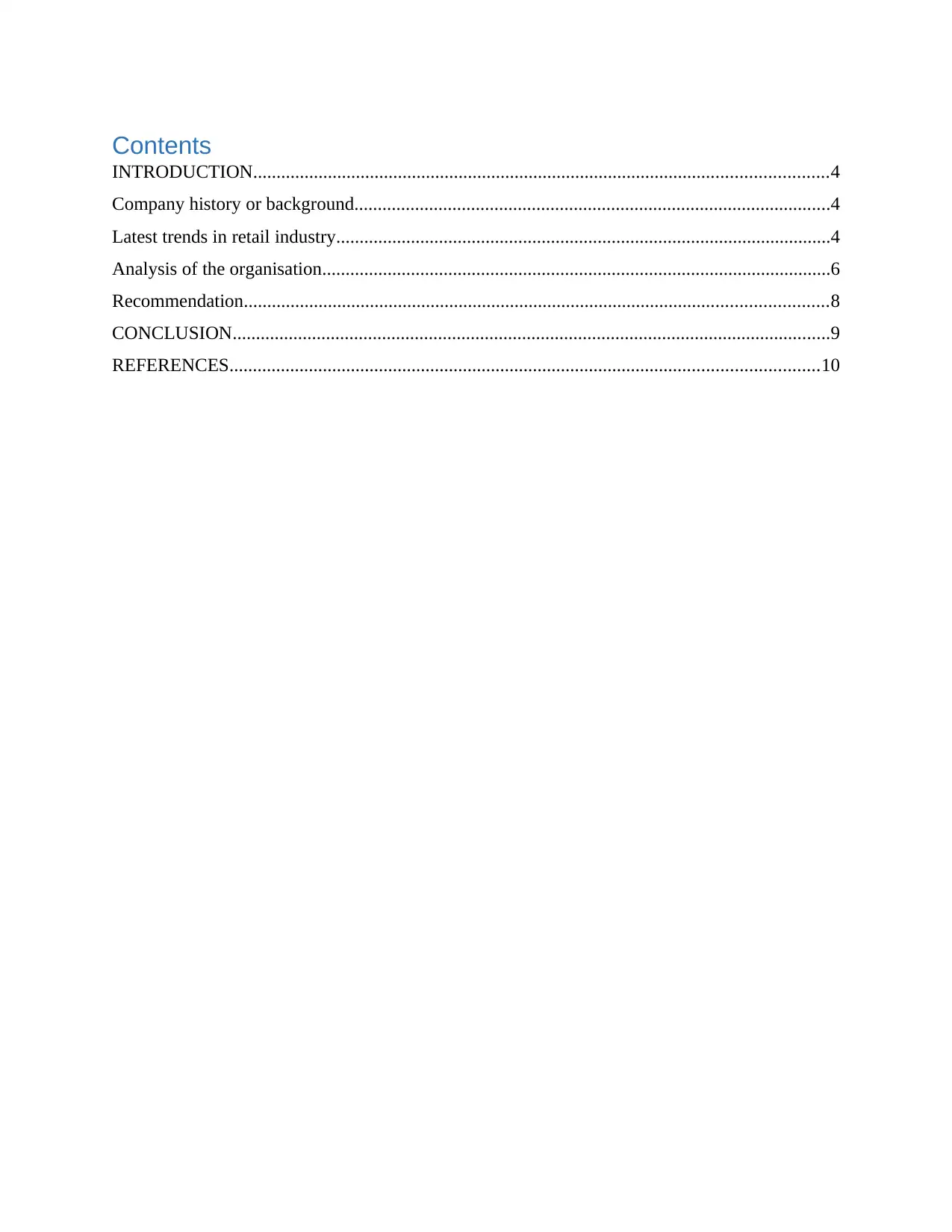
Contents
INTRODUCTION...........................................................................................................................4
Company history or background......................................................................................................4
Latest trends in retail industry..........................................................................................................4
Analysis of the organisation.............................................................................................................6
Recommendation.............................................................................................................................8
CONCLUSION................................................................................................................................9
REFERENCES..............................................................................................................................10
INTRODUCTION...........................................................................................................................4
Company history or background......................................................................................................4
Latest trends in retail industry..........................................................................................................4
Analysis of the organisation.............................................................................................................6
Recommendation.............................................................................................................................8
CONCLUSION................................................................................................................................9
REFERENCES..............................................................................................................................10
⊘ This is a preview!⊘
Do you want full access?
Subscribe today to unlock all pages.

Trusted by 1+ million students worldwide
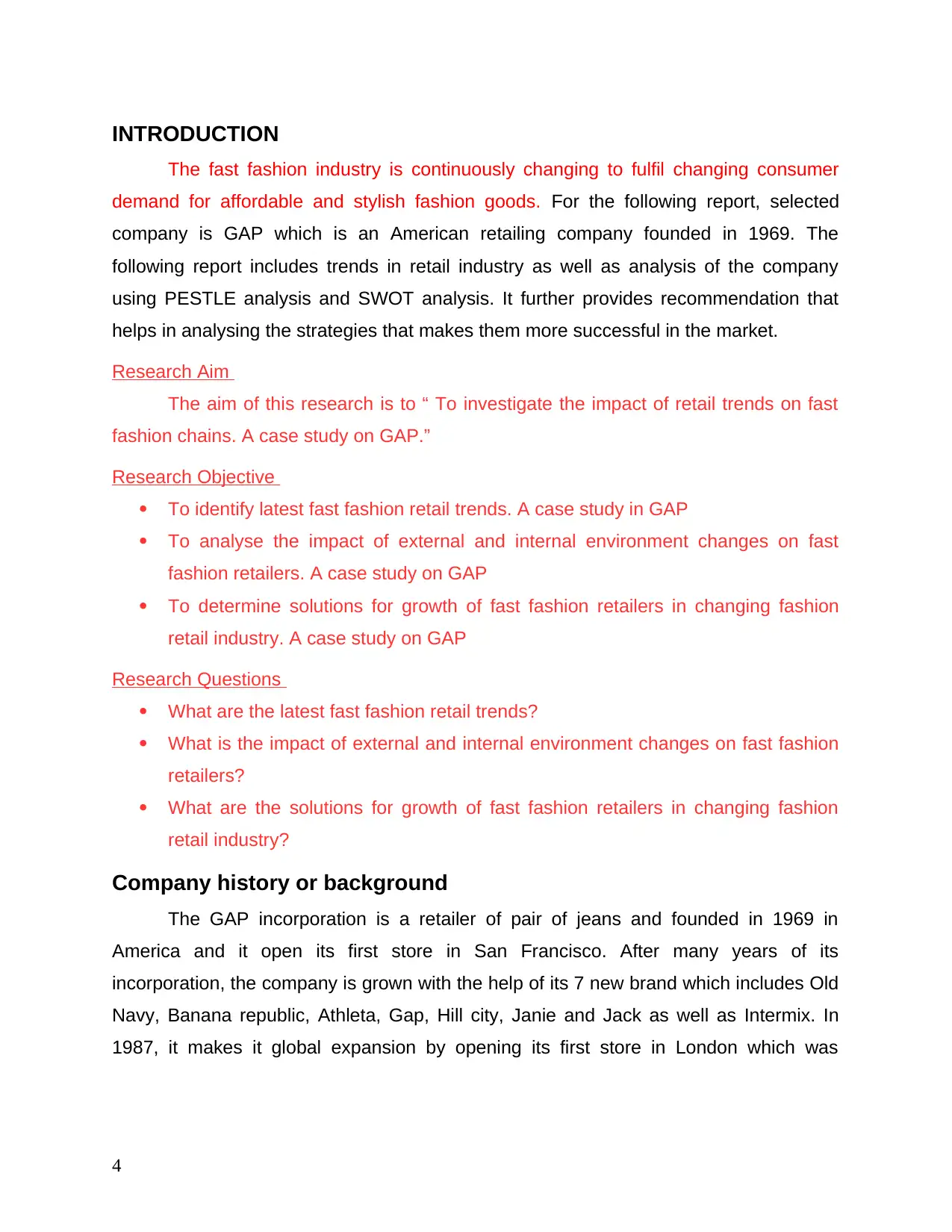
INTRODUCTION
The fast fashion industry is continuously changing to fulfil changing consumer
demand for affordable and stylish fashion goods. For the following report, selected
company is GAP which is an American retailing company founded in 1969. The
following report includes trends in retail industry as well as analysis of the company
using PESTLE analysis and SWOT analysis. It further provides recommendation that
helps in analysing the strategies that makes them more successful in the market.
Research Aim
The aim of this research is to “ To investigate the impact of retail trends on fast
fashion chains. A case study on GAP.”
Research Objective
To identify latest fast fashion retail trends. A case study in GAP
To analyse the impact of external and internal environment changes on fast
fashion retailers. A case study on GAP
To determine solutions for growth of fast fashion retailers in changing fashion
retail industry. A case study on GAP
Research Questions
What are the latest fast fashion retail trends?
What is the impact of external and internal environment changes on fast fashion
retailers?
What are the solutions for growth of fast fashion retailers in changing fashion
retail industry?
Company history or background
The GAP incorporation is a retailer of pair of jeans and founded in 1969 in
America and it open its first store in San Francisco. After many years of its
incorporation, the company is grown with the help of its 7 new brand which includes Old
Navy, Banana republic, Athleta, Gap, Hill city, Janie and Jack as well as Intermix. In
1987, it makes it global expansion by opening its first store in London which was
4
The fast fashion industry is continuously changing to fulfil changing consumer
demand for affordable and stylish fashion goods. For the following report, selected
company is GAP which is an American retailing company founded in 1969. The
following report includes trends in retail industry as well as analysis of the company
using PESTLE analysis and SWOT analysis. It further provides recommendation that
helps in analysing the strategies that makes them more successful in the market.
Research Aim
The aim of this research is to “ To investigate the impact of retail trends on fast
fashion chains. A case study on GAP.”
Research Objective
To identify latest fast fashion retail trends. A case study in GAP
To analyse the impact of external and internal environment changes on fast
fashion retailers. A case study on GAP
To determine solutions for growth of fast fashion retailers in changing fashion
retail industry. A case study on GAP
Research Questions
What are the latest fast fashion retail trends?
What is the impact of external and internal environment changes on fast fashion
retailers?
What are the solutions for growth of fast fashion retailers in changing fashion
retail industry?
Company history or background
The GAP incorporation is a retailer of pair of jeans and founded in 1969 in
America and it open its first store in San Francisco. After many years of its
incorporation, the company is grown with the help of its 7 new brand which includes Old
Navy, Banana republic, Athleta, Gap, Hill city, Janie and Jack as well as Intermix. In
1987, it makes it global expansion by opening its first store in London which was
4
Paraphrase This Document
Need a fresh take? Get an instant paraphrase of this document with our AI Paraphraser
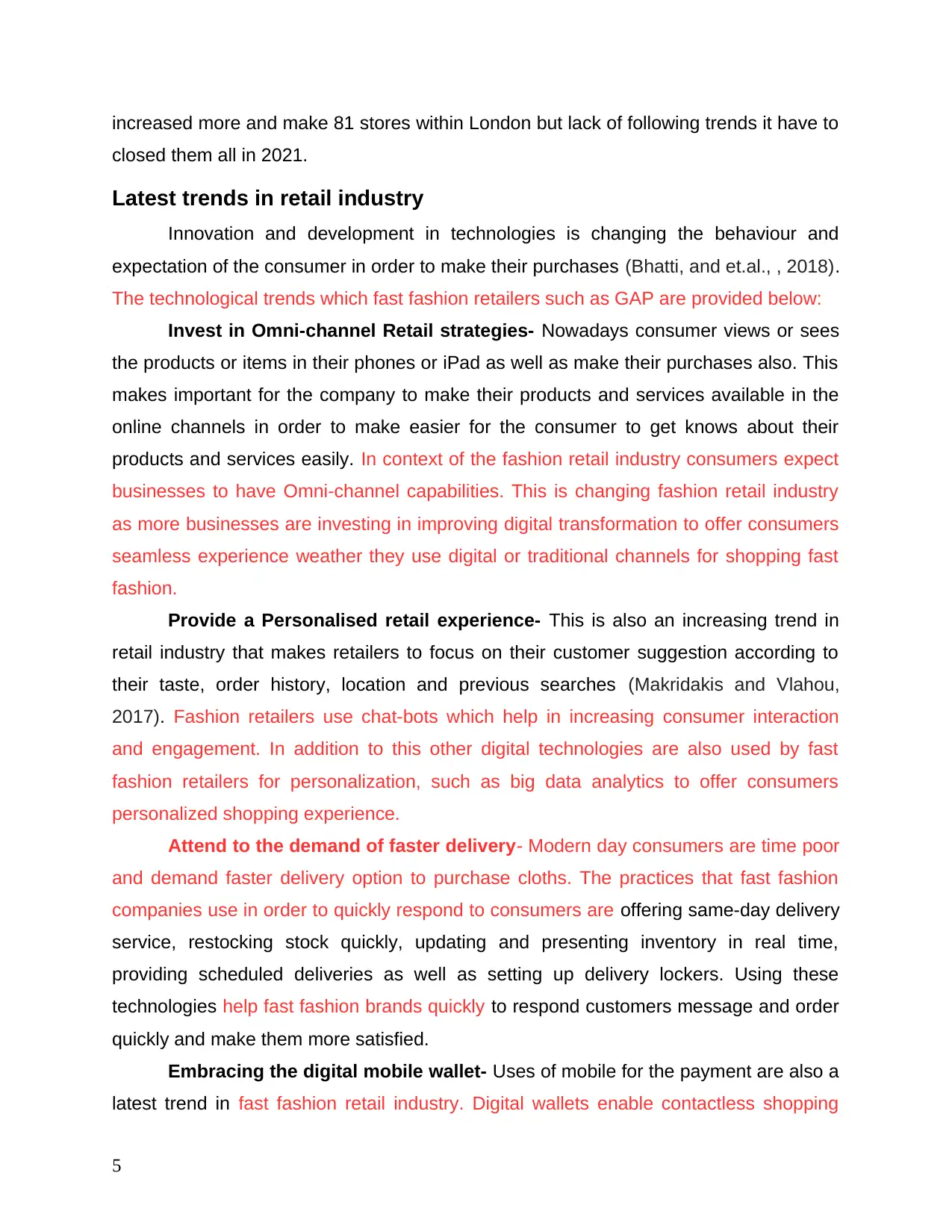
increased more and make 81 stores within London but lack of following trends it have to
closed them all in 2021.
Latest trends in retail industry
Innovation and development in technologies is changing the behaviour and
expectation of the consumer in order to make their purchases (Bhatti, and et.al., , 2018).
The technological trends which fast fashion retailers such as GAP are provided below:
Invest in Omni-channel Retail strategies- Nowadays consumer views or sees
the products or items in their phones or iPad as well as make their purchases also. This
makes important for the company to make their products and services available in the
online channels in order to make easier for the consumer to get knows about their
products and services easily. In context of the fashion retail industry consumers expect
businesses to have Omni-channel capabilities. This is changing fashion retail industry
as more businesses are investing in improving digital transformation to offer consumers
seamless experience weather they use digital or traditional channels for shopping fast
fashion.
Provide a Personalised retail experience- This is also an increasing trend in
retail industry that makes retailers to focus on their customer suggestion according to
their taste, order history, location and previous searches (Makridakis and Vlahou,
2017). Fashion retailers use chat-bots which help in increasing consumer interaction
and engagement. In addition to this other digital technologies are also used by fast
fashion retailers for personalization, such as big data analytics to offer consumers
personalized shopping experience.
Attend to the demand of faster delivery- Modern day consumers are time poor
and demand faster delivery option to purchase cloths. The practices that fast fashion
companies use in order to quickly respond to consumers are offering same-day delivery
service, restocking stock quickly, updating and presenting inventory in real time,
providing scheduled deliveries as well as setting up delivery lockers. Using these
technologies help fast fashion brands quickly to respond customers message and order
quickly and make them more satisfied.
Embracing the digital mobile wallet- Uses of mobile for the payment are also a
latest trend in fast fashion retail industry. Digital wallets enable contactless shopping
5
closed them all in 2021.
Latest trends in retail industry
Innovation and development in technologies is changing the behaviour and
expectation of the consumer in order to make their purchases (Bhatti, and et.al., , 2018).
The technological trends which fast fashion retailers such as GAP are provided below:
Invest in Omni-channel Retail strategies- Nowadays consumer views or sees
the products or items in their phones or iPad as well as make their purchases also. This
makes important for the company to make their products and services available in the
online channels in order to make easier for the consumer to get knows about their
products and services easily. In context of the fashion retail industry consumers expect
businesses to have Omni-channel capabilities. This is changing fashion retail industry
as more businesses are investing in improving digital transformation to offer consumers
seamless experience weather they use digital or traditional channels for shopping fast
fashion.
Provide a Personalised retail experience- This is also an increasing trend in
retail industry that makes retailers to focus on their customer suggestion according to
their taste, order history, location and previous searches (Makridakis and Vlahou,
2017). Fashion retailers use chat-bots which help in increasing consumer interaction
and engagement. In addition to this other digital technologies are also used by fast
fashion retailers for personalization, such as big data analytics to offer consumers
personalized shopping experience.
Attend to the demand of faster delivery- Modern day consumers are time poor
and demand faster delivery option to purchase cloths. The practices that fast fashion
companies use in order to quickly respond to consumers are offering same-day delivery
service, restocking stock quickly, updating and presenting inventory in real time,
providing scheduled deliveries as well as setting up delivery lockers. Using these
technologies help fast fashion brands quickly to respond customers message and order
quickly and make them more satisfied.
Embracing the digital mobile wallet- Uses of mobile for the payment are also a
latest trend in fast fashion retail industry. Digital wallets enable contactless shopping
5
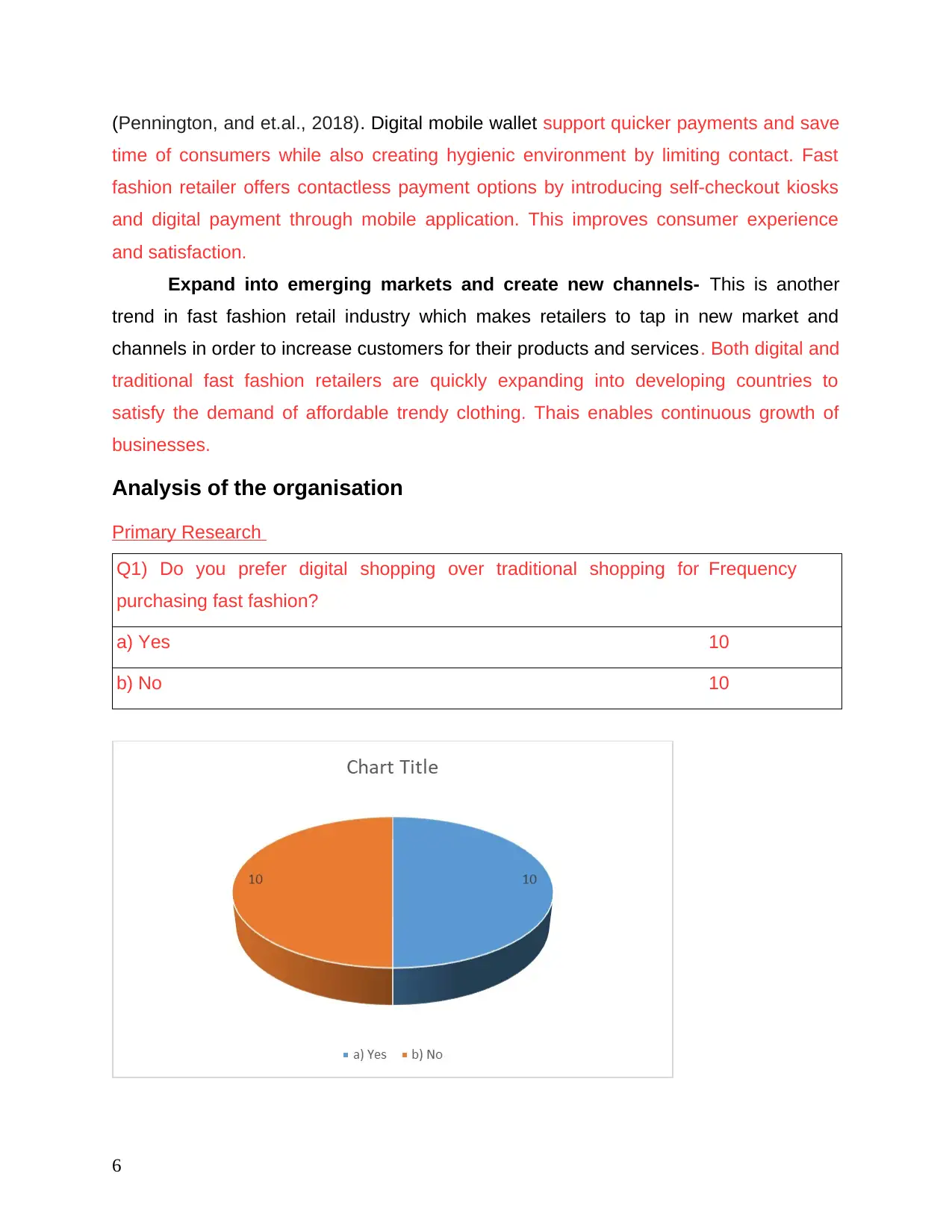
(Pennington, and et.al., 2018). Digital mobile wallet support quicker payments and save
time of consumers while also creating hygienic environment by limiting contact. Fast
fashion retailer offers contactless payment options by introducing self-checkout kiosks
and digital payment through mobile application. This improves consumer experience
and satisfaction.
Expand into emerging markets and create new channels- This is another
trend in fast fashion retail industry which makes retailers to tap in new market and
channels in order to increase customers for their products and services. Both digital and
traditional fast fashion retailers are quickly expanding into developing countries to
satisfy the demand of affordable trendy clothing. Thais enables continuous growth of
businesses.
Analysis of the organisation
Primary Research
Q1) Do you prefer digital shopping over traditional shopping for
purchasing fast fashion?
Frequency
a) Yes 10
b) No 10
6
time of consumers while also creating hygienic environment by limiting contact. Fast
fashion retailer offers contactless payment options by introducing self-checkout kiosks
and digital payment through mobile application. This improves consumer experience
and satisfaction.
Expand into emerging markets and create new channels- This is another
trend in fast fashion retail industry which makes retailers to tap in new market and
channels in order to increase customers for their products and services. Both digital and
traditional fast fashion retailers are quickly expanding into developing countries to
satisfy the demand of affordable trendy clothing. Thais enables continuous growth of
businesses.
Analysis of the organisation
Primary Research
Q1) Do you prefer digital shopping over traditional shopping for
purchasing fast fashion?
Frequency
a) Yes 10
b) No 10
6
⊘ This is a preview!⊘
Do you want full access?
Subscribe today to unlock all pages.

Trusted by 1+ million students worldwide
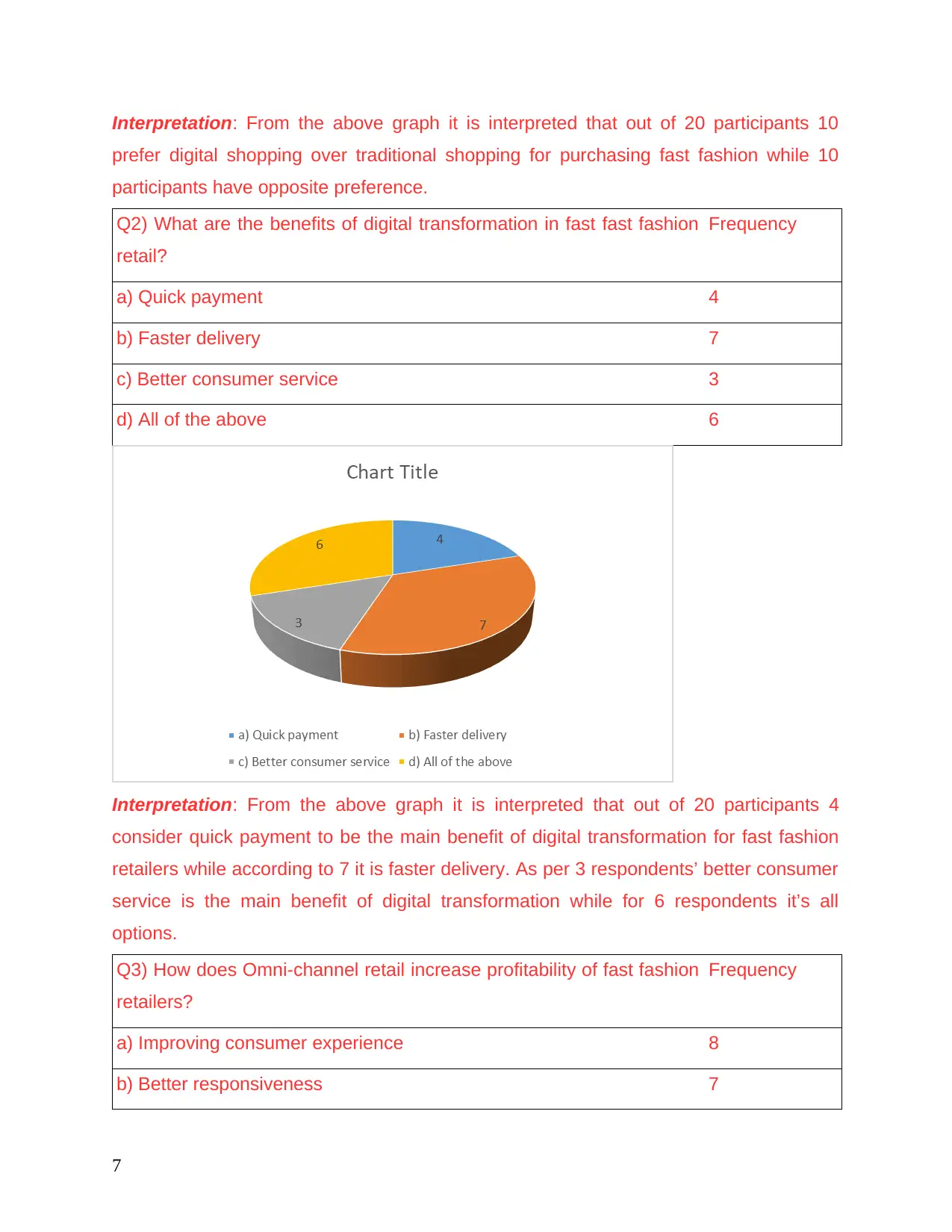
Interpretation: From the above graph it is interpreted that out of 20 participants 10
prefer digital shopping over traditional shopping for purchasing fast fashion while 10
participants have opposite preference.
Q2) What are the benefits of digital transformation in fast fast fashion
retail?
Frequency
a) Quick payment 4
b) Faster delivery 7
c) Better consumer service 3
d) All of the above 6
Interpretation: From the above graph it is interpreted that out of 20 participants 4
consider quick payment to be the main benefit of digital transformation for fast fashion
retailers while according to 7 it is faster delivery. As per 3 respondents’ better consumer
service is the main benefit of digital transformation while for 6 respondents it’s all
options.
Q3) How does Omni-channel retail increase profitability of fast fashion
retailers?
Frequency
a) Improving consumer experience 8
b) Better responsiveness 7
7
prefer digital shopping over traditional shopping for purchasing fast fashion while 10
participants have opposite preference.
Q2) What are the benefits of digital transformation in fast fast fashion
retail?
Frequency
a) Quick payment 4
b) Faster delivery 7
c) Better consumer service 3
d) All of the above 6
Interpretation: From the above graph it is interpreted that out of 20 participants 4
consider quick payment to be the main benefit of digital transformation for fast fashion
retailers while according to 7 it is faster delivery. As per 3 respondents’ better consumer
service is the main benefit of digital transformation while for 6 respondents it’s all
options.
Q3) How does Omni-channel retail increase profitability of fast fashion
retailers?
Frequency
a) Improving consumer experience 8
b) Better responsiveness 7
7
Paraphrase This Document
Need a fresh take? Get an instant paraphrase of this document with our AI Paraphraser
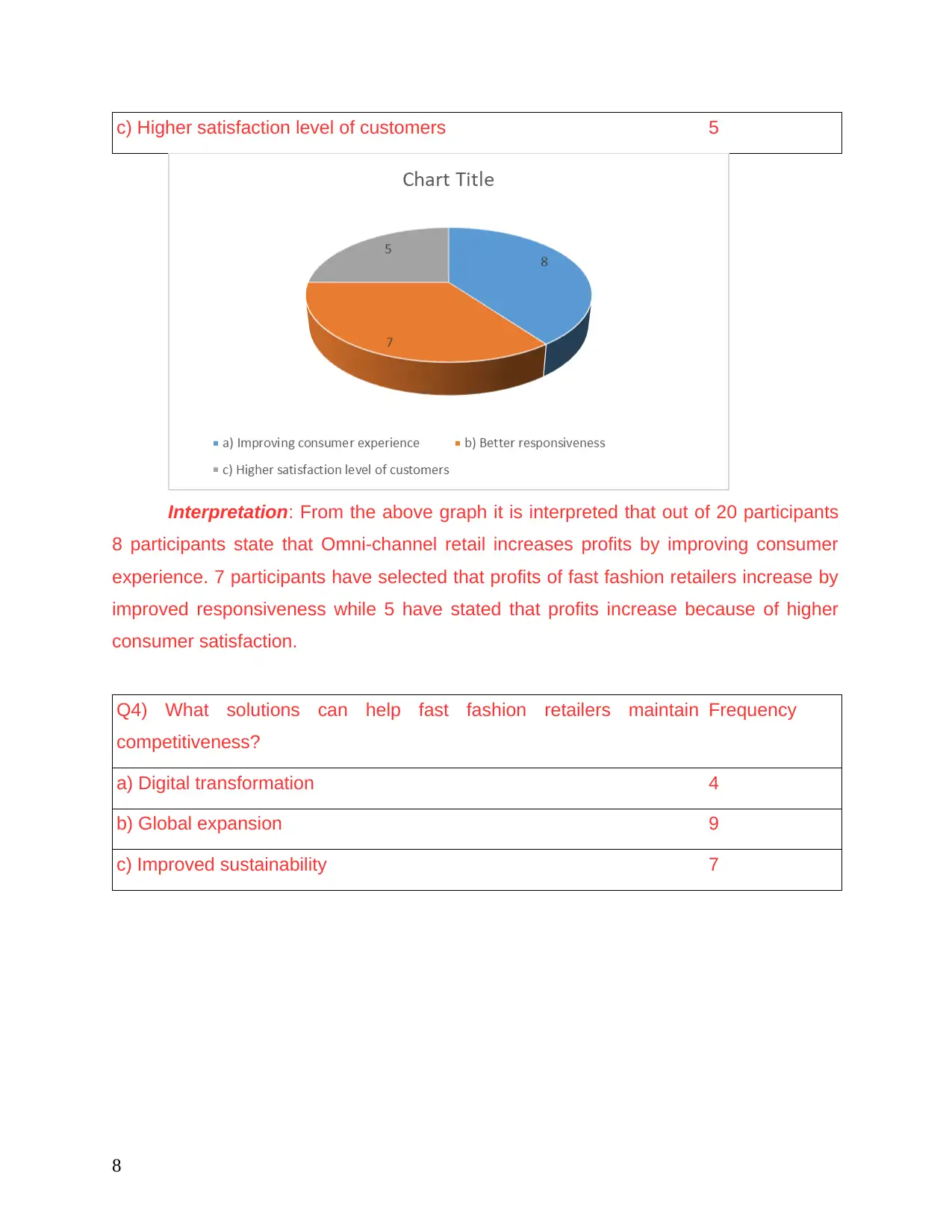
c) Higher satisfaction level of customers 5
Interpretation: From the above graph it is interpreted that out of 20 participants
8 participants state that Omni-channel retail increases profits by improving consumer
experience. 7 participants have selected that profits of fast fashion retailers increase by
improved responsiveness while 5 have stated that profits increase because of higher
consumer satisfaction.
Q4) What solutions can help fast fashion retailers maintain
competitiveness?
Frequency
a) Digital transformation 4
b) Global expansion 9
c) Improved sustainability 7
8
Interpretation: From the above graph it is interpreted that out of 20 participants
8 participants state that Omni-channel retail increases profits by improving consumer
experience. 7 participants have selected that profits of fast fashion retailers increase by
improved responsiveness while 5 have stated that profits increase because of higher
consumer satisfaction.
Q4) What solutions can help fast fashion retailers maintain
competitiveness?
Frequency
a) Digital transformation 4
b) Global expansion 9
c) Improved sustainability 7
8
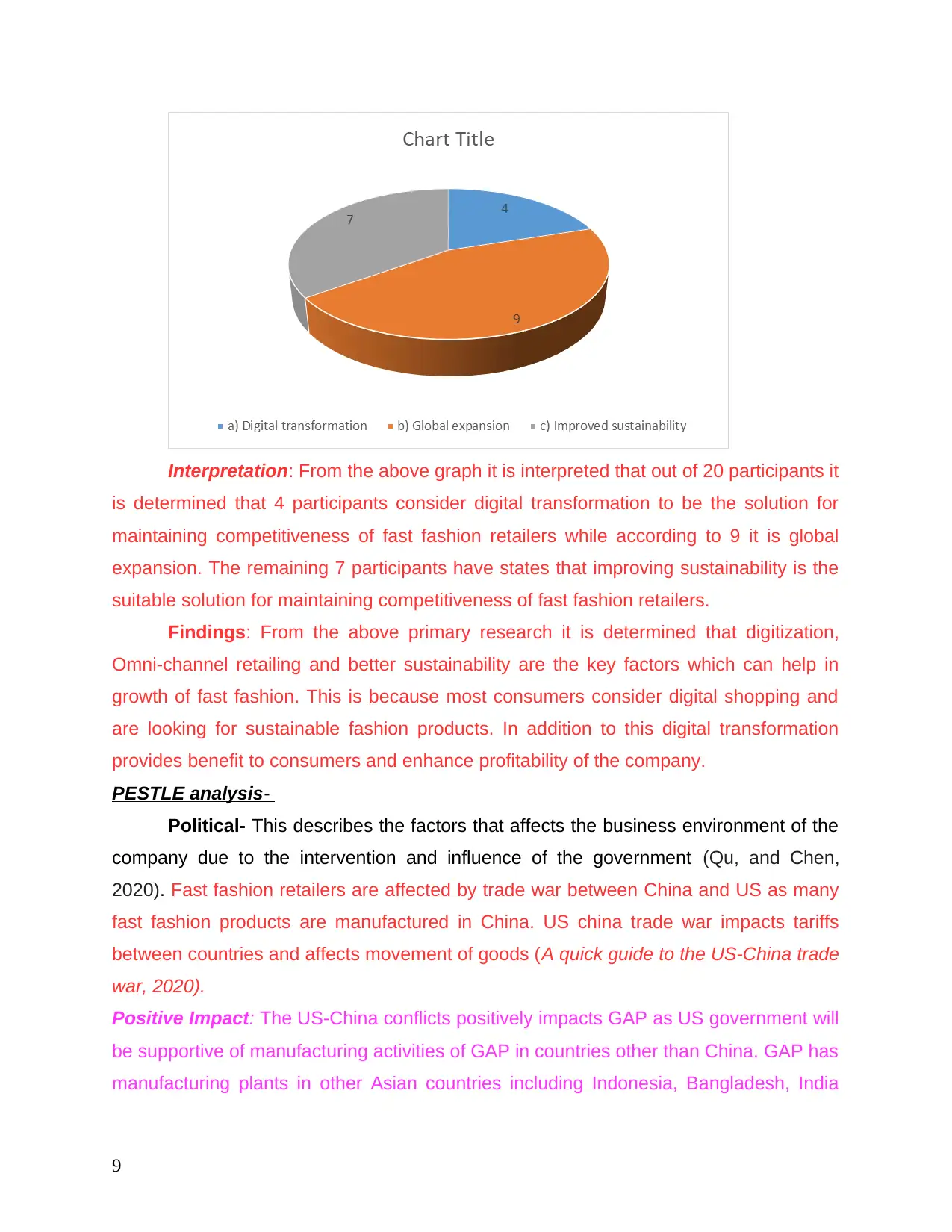
Interpretation: From the above graph it is interpreted that out of 20 participants it
is determined that 4 participants consider digital transformation to be the solution for
maintaining competitiveness of fast fashion retailers while according to 9 it is global
expansion. The remaining 7 participants have states that improving sustainability is the
suitable solution for maintaining competitiveness of fast fashion retailers.
Findings: From the above primary research it is determined that digitization,
Omni-channel retailing and better sustainability are the key factors which can help in
growth of fast fashion. This is because most consumers consider digital shopping and
are looking for sustainable fashion products. In addition to this digital transformation
provides benefit to consumers and enhance profitability of the company.
PESTLE analysis-
Political- This describes the factors that affects the business environment of the
company due to the intervention and influence of the government (Qu, and Chen,
2020). Fast fashion retailers are affected by trade war between China and US as many
fast fashion products are manufactured in China. US china trade war impacts tariffs
between countries and affects movement of goods (A quick guide to the US-China trade
war, 2020).
Positive Impact: The US-China conflicts positively impacts GAP as US government will
be supportive of manufacturing activities of GAP in countries other than China. GAP has
manufacturing plants in other Asian countries including Indonesia, Bangladesh, India
9
is determined that 4 participants consider digital transformation to be the solution for
maintaining competitiveness of fast fashion retailers while according to 9 it is global
expansion. The remaining 7 participants have states that improving sustainability is the
suitable solution for maintaining competitiveness of fast fashion retailers.
Findings: From the above primary research it is determined that digitization,
Omni-channel retailing and better sustainability are the key factors which can help in
growth of fast fashion. This is because most consumers consider digital shopping and
are looking for sustainable fashion products. In addition to this digital transformation
provides benefit to consumers and enhance profitability of the company.
PESTLE analysis-
Political- This describes the factors that affects the business environment of the
company due to the intervention and influence of the government (Qu, and Chen,
2020). Fast fashion retailers are affected by trade war between China and US as many
fast fashion products are manufactured in China. US china trade war impacts tariffs
between countries and affects movement of goods (A quick guide to the US-China trade
war, 2020).
Positive Impact: The US-China conflicts positively impacts GAP as US government will
be supportive of manufacturing activities of GAP in countries other than China. GAP has
manufacturing plants in other Asian countries including Indonesia, Bangladesh, India
9
⊘ This is a preview!⊘
Do you want full access?
Subscribe today to unlock all pages.

Trusted by 1+ million students worldwide
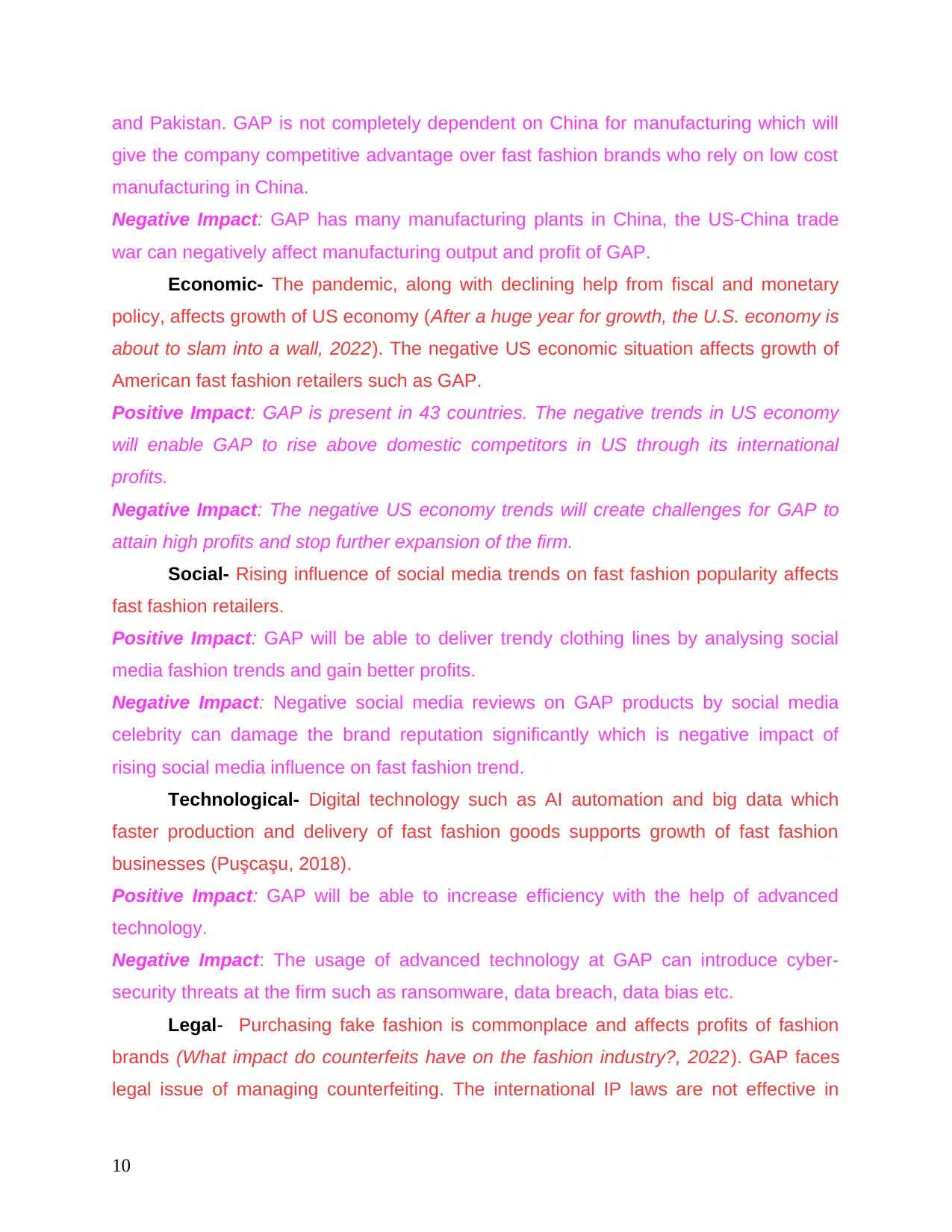
and Pakistan. GAP is not completely dependent on China for manufacturing which will
give the company competitive advantage over fast fashion brands who rely on low cost
manufacturing in China.
Negative Impact: GAP has many manufacturing plants in China, the US-China trade
war can negatively affect manufacturing output and profit of GAP.
Economic- The pandemic, along with declining help from fiscal and monetary
policy, affects growth of US economy (After a huge year for growth, the U.S. economy is
about to slam into a wall, 2022). The negative US economic situation affects growth of
American fast fashion retailers such as GAP.
Positive Impact: GAP is present in 43 countries. The negative trends in US economy
will enable GAP to rise above domestic competitors in US through its international
profits.
Negative Impact: The negative US economy trends will create challenges for GAP to
attain high profits and stop further expansion of the firm.
Social- Rising influence of social media trends on fast fashion popularity affects
fast fashion retailers.
Positive Impact: GAP will be able to deliver trendy clothing lines by analysing social
media fashion trends and gain better profits.
Negative Impact: Negative social media reviews on GAP products by social media
celebrity can damage the brand reputation significantly which is negative impact of
rising social media influence on fast fashion trend.
Technological- Digital technology such as AI automation and big data which
faster production and delivery of fast fashion goods supports growth of fast fashion
businesses (Puşcaşu, 2018).
Positive Impact: GAP will be able to increase efficiency with the help of advanced
technology.
Negative Impact: The usage of advanced technology at GAP can introduce cyber-
security threats at the firm such as ransomware, data breach, data bias etc.
Legal- Purchasing fake fashion is commonplace and affects profits of fashion
brands (What impact do counterfeits have on the fashion industry?, 2022). GAP faces
legal issue of managing counterfeiting. The international IP laws are not effective in
10
give the company competitive advantage over fast fashion brands who rely on low cost
manufacturing in China.
Negative Impact: GAP has many manufacturing plants in China, the US-China trade
war can negatively affect manufacturing output and profit of GAP.
Economic- The pandemic, along with declining help from fiscal and monetary
policy, affects growth of US economy (After a huge year for growth, the U.S. economy is
about to slam into a wall, 2022). The negative US economic situation affects growth of
American fast fashion retailers such as GAP.
Positive Impact: GAP is present in 43 countries. The negative trends in US economy
will enable GAP to rise above domestic competitors in US through its international
profits.
Negative Impact: The negative US economy trends will create challenges for GAP to
attain high profits and stop further expansion of the firm.
Social- Rising influence of social media trends on fast fashion popularity affects
fast fashion retailers.
Positive Impact: GAP will be able to deliver trendy clothing lines by analysing social
media fashion trends and gain better profits.
Negative Impact: Negative social media reviews on GAP products by social media
celebrity can damage the brand reputation significantly which is negative impact of
rising social media influence on fast fashion trend.
Technological- Digital technology such as AI automation and big data which
faster production and delivery of fast fashion goods supports growth of fast fashion
businesses (Puşcaşu, 2018).
Positive Impact: GAP will be able to increase efficiency with the help of advanced
technology.
Negative Impact: The usage of advanced technology at GAP can introduce cyber-
security threats at the firm such as ransomware, data breach, data bias etc.
Legal- Purchasing fake fashion is commonplace and affects profits of fashion
brands (What impact do counterfeits have on the fashion industry?, 2022). GAP faces
legal issue of managing counterfeiting. The international IP laws are not effective in
10
Paraphrase This Document
Need a fresh take? Get an instant paraphrase of this document with our AI Paraphraser
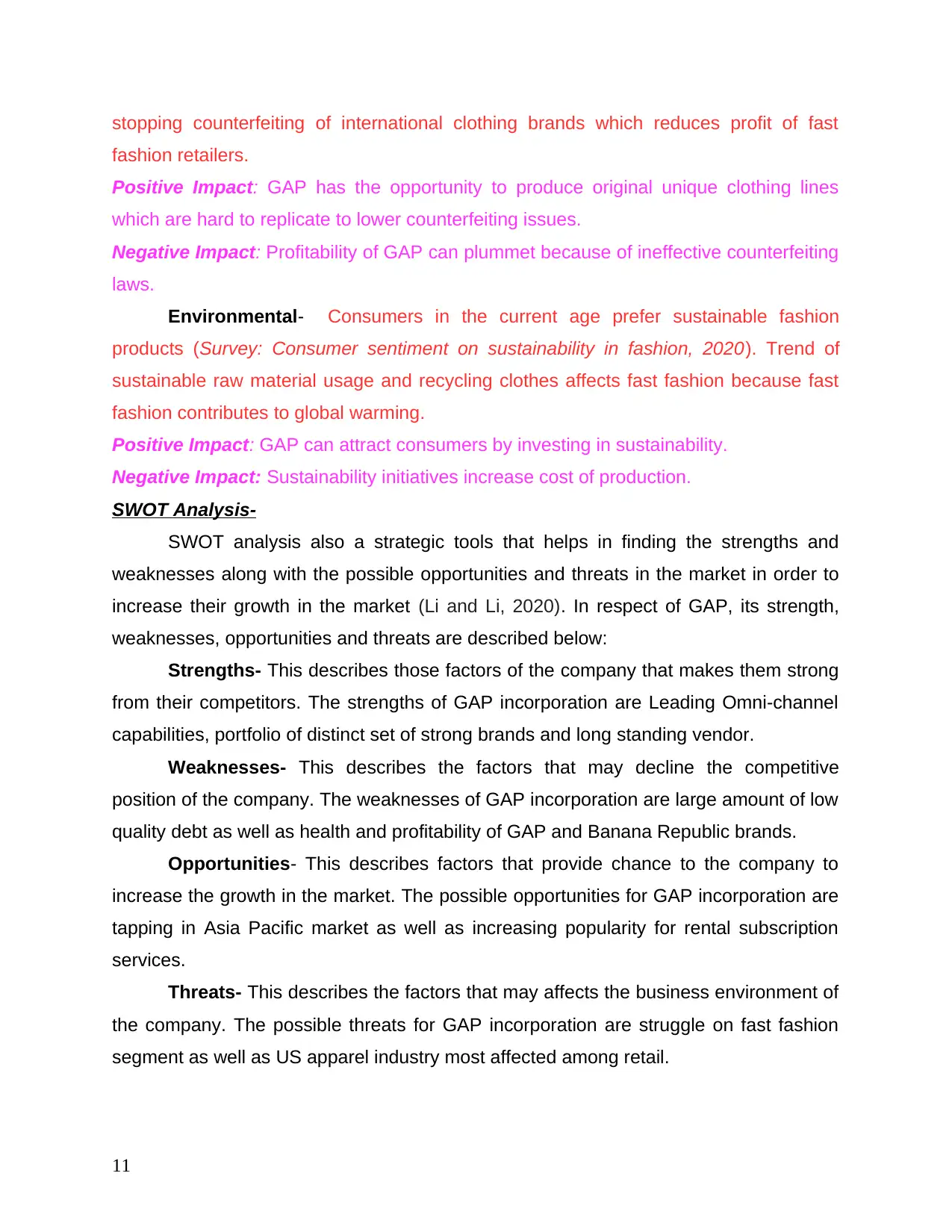
stopping counterfeiting of international clothing brands which reduces profit of fast
fashion retailers.
Positive Impact: GAP has the opportunity to produce original unique clothing lines
which are hard to replicate to lower counterfeiting issues.
Negative Impact: Profitability of GAP can plummet because of ineffective counterfeiting
laws.
Environmental- Consumers in the current age prefer sustainable fashion
products (Survey: Consumer sentiment on sustainability in fashion, 2020). Trend of
sustainable raw material usage and recycling clothes affects fast fashion because fast
fashion contributes to global warming.
Positive Impact: GAP can attract consumers by investing in sustainability.
Negative Impact: Sustainability initiatives increase cost of production.
SWOT Analysis-
SWOT analysis also a strategic tools that helps in finding the strengths and
weaknesses along with the possible opportunities and threats in the market in order to
increase their growth in the market (Li and Li, 2020). In respect of GAP, its strength,
weaknesses, opportunities and threats are described below:
Strengths- This describes those factors of the company that makes them strong
from their competitors. The strengths of GAP incorporation are Leading Omni-channel
capabilities, portfolio of distinct set of strong brands and long standing vendor.
Weaknesses- This describes the factors that may decline the competitive
position of the company. The weaknesses of GAP incorporation are large amount of low
quality debt as well as health and profitability of GAP and Banana Republic brands.
Opportunities- This describes factors that provide chance to the company to
increase the growth in the market. The possible opportunities for GAP incorporation are
tapping in Asia Pacific market as well as increasing popularity for rental subscription
services.
Threats- This describes the factors that may affects the business environment of
the company. The possible threats for GAP incorporation are struggle on fast fashion
segment as well as US apparel industry most affected among retail.
11
fashion retailers.
Positive Impact: GAP has the opportunity to produce original unique clothing lines
which are hard to replicate to lower counterfeiting issues.
Negative Impact: Profitability of GAP can plummet because of ineffective counterfeiting
laws.
Environmental- Consumers in the current age prefer sustainable fashion
products (Survey: Consumer sentiment on sustainability in fashion, 2020). Trend of
sustainable raw material usage and recycling clothes affects fast fashion because fast
fashion contributes to global warming.
Positive Impact: GAP can attract consumers by investing in sustainability.
Negative Impact: Sustainability initiatives increase cost of production.
SWOT Analysis-
SWOT analysis also a strategic tools that helps in finding the strengths and
weaknesses along with the possible opportunities and threats in the market in order to
increase their growth in the market (Li and Li, 2020). In respect of GAP, its strength,
weaknesses, opportunities and threats are described below:
Strengths- This describes those factors of the company that makes them strong
from their competitors. The strengths of GAP incorporation are Leading Omni-channel
capabilities, portfolio of distinct set of strong brands and long standing vendor.
Weaknesses- This describes the factors that may decline the competitive
position of the company. The weaknesses of GAP incorporation are large amount of low
quality debt as well as health and profitability of GAP and Banana Republic brands.
Opportunities- This describes factors that provide chance to the company to
increase the growth in the market. The possible opportunities for GAP incorporation are
tapping in Asia Pacific market as well as increasing popularity for rental subscription
services.
Threats- This describes the factors that may affects the business environment of
the company. The possible threats for GAP incorporation are struggle on fast fashion
segment as well as US apparel industry most affected among retail.
11
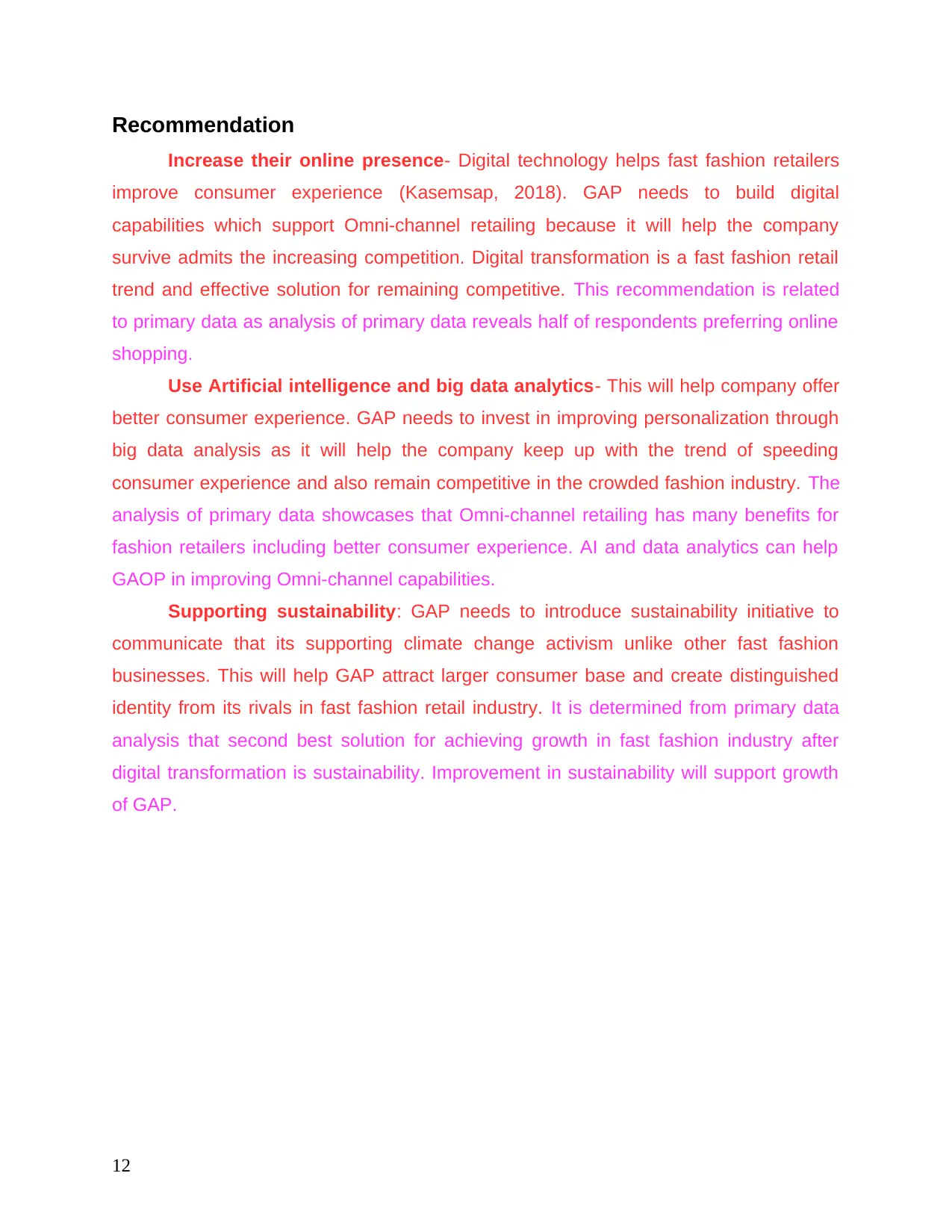
Recommendation
Increase their online presence- Digital technology helps fast fashion retailers
improve consumer experience (Kasemsap, 2018). GAP needs to build digital
capabilities which support Omni-channel retailing because it will help the company
survive admits the increasing competition. Digital transformation is a fast fashion retail
trend and effective solution for remaining competitive. This recommendation is related
to primary data as analysis of primary data reveals half of respondents preferring online
shopping.
Use Artificial intelligence and big data analytics- This will help company offer
better consumer experience. GAP needs to invest in improving personalization through
big data analysis as it will help the company keep up with the trend of speeding
consumer experience and also remain competitive in the crowded fashion industry. The
analysis of primary data showcases that Omni-channel retailing has many benefits for
fashion retailers including better consumer experience. AI and data analytics can help
GAOP in improving Omni-channel capabilities.
Supporting sustainability: GAP needs to introduce sustainability initiative to
communicate that its supporting climate change activism unlike other fast fashion
businesses. This will help GAP attract larger consumer base and create distinguished
identity from its rivals in fast fashion retail industry. It is determined from primary data
analysis that second best solution for achieving growth in fast fashion industry after
digital transformation is sustainability. Improvement in sustainability will support growth
of GAP.
12
Increase their online presence- Digital technology helps fast fashion retailers
improve consumer experience (Kasemsap, 2018). GAP needs to build digital
capabilities which support Omni-channel retailing because it will help the company
survive admits the increasing competition. Digital transformation is a fast fashion retail
trend and effective solution for remaining competitive. This recommendation is related
to primary data as analysis of primary data reveals half of respondents preferring online
shopping.
Use Artificial intelligence and big data analytics- This will help company offer
better consumer experience. GAP needs to invest in improving personalization through
big data analysis as it will help the company keep up with the trend of speeding
consumer experience and also remain competitive in the crowded fashion industry. The
analysis of primary data showcases that Omni-channel retailing has many benefits for
fashion retailers including better consumer experience. AI and data analytics can help
GAOP in improving Omni-channel capabilities.
Supporting sustainability: GAP needs to introduce sustainability initiative to
communicate that its supporting climate change activism unlike other fast fashion
businesses. This will help GAP attract larger consumer base and create distinguished
identity from its rivals in fast fashion retail industry. It is determined from primary data
analysis that second best solution for achieving growth in fast fashion industry after
digital transformation is sustainability. Improvement in sustainability will support growth
of GAP.
12
⊘ This is a preview!⊘
Do you want full access?
Subscribe today to unlock all pages.

Trusted by 1+ million students worldwide
1 out of 15
Related Documents
Your All-in-One AI-Powered Toolkit for Academic Success.
+13062052269
info@desklib.com
Available 24*7 on WhatsApp / Email
![[object Object]](/_next/static/media/star-bottom.7253800d.svg)
Unlock your academic potential
Copyright © 2020–2025 A2Z Services. All Rights Reserved. Developed and managed by ZUCOL.





